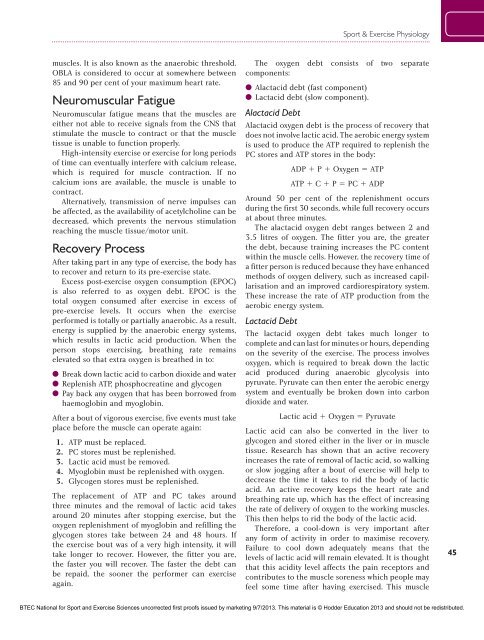btec-national-sport-level-3-sample-pages-9781444111989.pdf
btec-national-sport-level-3-sample-pages-9781444111989.pdf
btec-national-sport-level-3-sample-pages-9781444111989.pdf
You also want an ePaper? Increase the reach of your titles
YUMPU automatically turns print PDFs into web optimized ePapers that Google loves.
Sport & Exercise Physiology<br />
muscles. It is also known as the anaerobic threshold.<br />
OBLA is considered to occur at somewhere between<br />
85 and 90 per cent of your maximum heart rate.<br />
Neuromuscular Fatigue<br />
Neuromuscular fatigue means that the muscles are<br />
either not able to receive signals from the CNS that<br />
stimulate the muscle to contract or that the muscle<br />
tissue is unable to function properly.<br />
High-intensity exercise or exercise for long periods<br />
of time can eventually interfere with calcium release,<br />
which is required for muscle contraction. If no<br />
calcium ions are available, the muscle is unable to<br />
contract.<br />
Alternatively, transmission of nerve impulses can<br />
be affected, as the availability of acetylcholine can be<br />
decreased, which prevents the nervous stimulation<br />
reaching the muscle tissue/motor unit.<br />
Recovery Process<br />
After taking part in any type of exercise, the body has<br />
to recover and return to its pre-exercise state.<br />
Excess post-exercise oxygen consumption (EPOC)<br />
is also referred to as oxygen debt. EPOC is the<br />
total oxygen consumed after exercise in excess of<br />
pre-exercise <strong>level</strong>s. It occurs when the exercise<br />
performed is totally or partially anaerobic. As a result,<br />
energy is supplied by the anaerobic energy systems,<br />
which results in lactic acid production. When the<br />
person stops exercising, breathing rate remains<br />
elevated so that extra oxygen is breathed in to:<br />
●●<br />
Break down lactic acid to carbon dioxide and water<br />
●●<br />
Replenish ATP, phosphocreatine and glycogen<br />
●●<br />
Pay back any oxygen that has been borrowed from<br />
haemoglobin and myoglobin.<br />
After a bout of vigorous exercise, five events must take<br />
place before the muscle can operate again:<br />
1. ATP must be replaced.<br />
2. PC stores must be replenished.<br />
3. Lactic acid must be removed.<br />
4. Myoglobin must be replenished with oxygen.<br />
5. Glycogen stores must be replenished.<br />
The replacement of ATP and PC takes around<br />
three minutes and the removal of lactic acid takes<br />
around 20 minutes after stopping exercise, but the<br />
oxygen replenishment of myoglobin and refilling the<br />
glycogen stores take between 24 and 48 hours. If<br />
the exercise bout was of a very high intensity, it will<br />
take longer to recover. However, the fitter you are,<br />
the faster you will recover. The faster the debt can<br />
be repaid, the sooner the performer can exercise<br />
again.<br />
The oxygen debt consists of two separate<br />
components:<br />
●●<br />
Alactacid debt (fast component)<br />
●●<br />
Lactacid debt (slow component).<br />
Alactacid Debt<br />
Alactacid oxygen debt is the process of recovery that<br />
does not involve lactic acid. The aerobic energy system<br />
is used to produce the ATP required to replenish the<br />
PC stores and ATP stores in the body:<br />
ADP 1 P 1 Oxygen 5 ATP<br />
ATP 1 C 1 P 5 PC 1 ADP<br />
Around 50 per cent of the replenishment occurs<br />
during the first 30 seconds, while full recovery occurs<br />
at about three minutes.<br />
The alactacid oxygen debt ranges between 2 and<br />
3.5 litres of oxygen. The fitter you are, the greater<br />
the debt, because training increases the PC content<br />
within the muscle cells. However, the recovery time of<br />
a fitter person is reduced because they have enhanced<br />
methods of oxygen delivery, such as increased capillarisation<br />
and an improved cardiorespiratory system.<br />
These increase the rate of ATP production from the<br />
aerobic energy system.<br />
Lactacid Debt<br />
The lactacid oxygen debt takes much longer to<br />
complete and can last for minutes or hours, depending<br />
on the severity of the exercise. The process involves<br />
oxygen, which is required to break down the lactic<br />
acid produced during anaerobic glycolysis into<br />
pyruvate. Pyruvate can then enter the aerobic energy<br />
system and eventually be broken down into carbon<br />
dioxide and water.<br />
Lactic acid 1 Oxygen 5 Pyruvate<br />
Lactic acid can also be converted in the liver to<br />
glycogen and stored either in the liver or in muscle<br />
tissue. Research has shown that an active recovery<br />
increases the rate of removal of lactic acid, so walking<br />
or slow jogging after a bout of exercise will help to<br />
decrease the time it takes to rid the body of lactic<br />
acid. An active recovery keeps the heart rate and<br />
breathing rate up, which has the effect of increasing<br />
the rate of delivery of oxygen to the working muscles.<br />
This then helps to rid the body of the lactic acid.<br />
Therefore, a cool-down is very important after<br />
any form of activity in order to maximise recovery.<br />
Failure to cool down adequately means that the<br />
<strong>level</strong>s of lactic acid will remain elevated. It is thought<br />
that this acidity <strong>level</strong> affects the pain receptors and<br />
contributes to the muscle soreness which people may<br />
feel some time after having exercised. This muscle<br />
45<br />
BTEC National for Sport and Exercise Sciences uncorrected first proofs issued by marketing 9/7/2013. This material is © Hodder Education 2013 and should not be redistributed.


